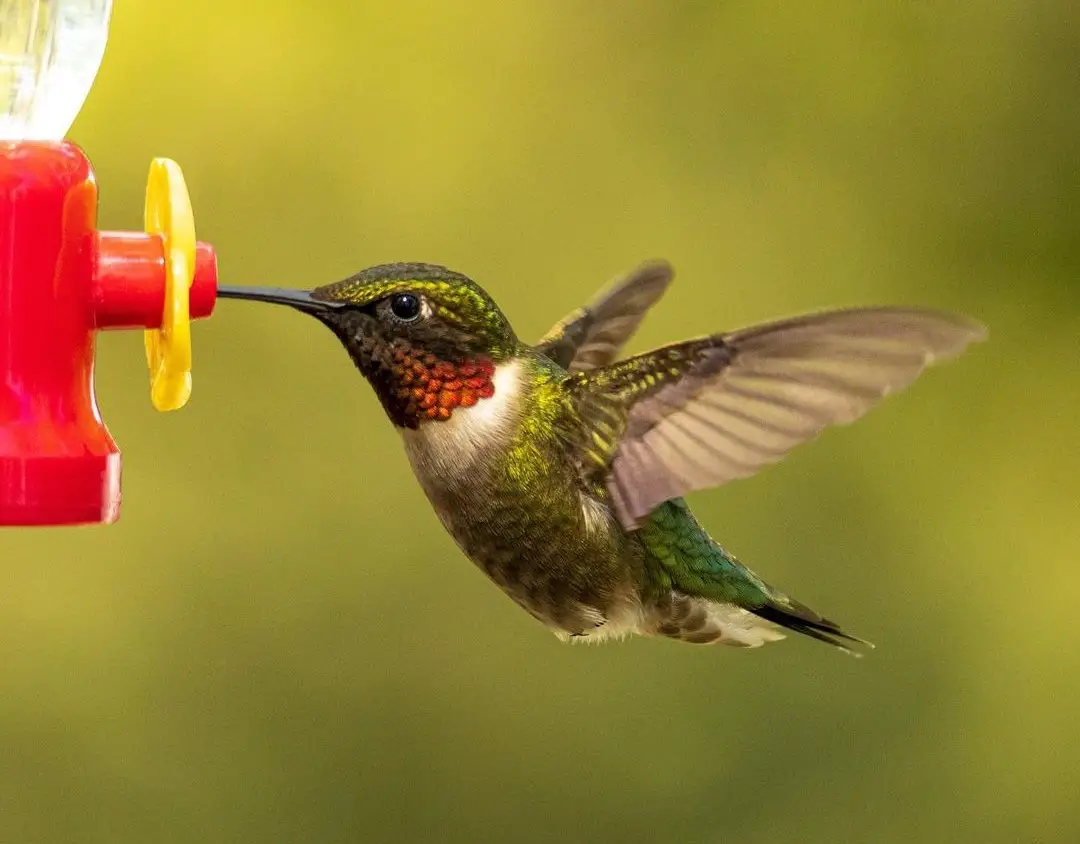This post contains affiliate links.
What types of hummingbirds are found in North Dakota?
- There are 5 hummingbird species found in North Dakota.
- Anna’s – (Calypte anna)
- Calliope – (Selasphorus calliope)
- Broad-tailed – (Selsaphoris platycercus)
- Ruby-throated – (Archilochus colubris)
- Rufous – (Selasphorus rufus)
North Dakota, known as the Peace Garden State, is home to one out of the five hummingbird species, the Ruby-throated hummingbird.
The United States Department of Agriculture, (USDA) identifies the Anna’s, Broad-tailed, Ruby-throated, and Rufous hummingbirds as being found in North Dakota.
The USDA also says that the Ruby-throated hummingbirds are the only hummingbird that breeds and nests in North Dakota.
Other North Dakota hummingbird enthusiasts claim the Calliope hummingbird is also occasionally seen in North Dakota.
While it is easy to assume all hummingbirds are the same when we see them only as a jewel-toned flash of color as they jet around our hanging flowers and porches; they have different temperaments, varied nesting habits, diverse coloring and reside in multiple geographical ranges.
There are 3 categories of hummingbirds found in North Dakota. Year-round natives, seasonal, and rare hummingbirds.
Hummingbirds are known to exist within certain established ranges, either as year-round natives or as part of a migratory cycle. There are hummingbirds that are rarely found in North Dakota that show up at feeders far outside their established range and are known in the ornithological circles as “vagrants”.
Categories of Hummingbirds:
Year-Round/Native Hummingbirds:
- Ruby-throated (some may be year-round, others migrate)
- Rufous (some may be year-round, others migrate)
According to AllAboutBirds.org, there are a couple of species of hummingbirds that tolerate very cold weather and are documented as winter residents in Michigan, upstate New York, Massachusetts, and Wisconsin. They are the Ruby-throated and Rufous hummingbirds. These scant few would be known as year-round/native hummingbirds.
I would expect these same hummingbirds to be seen in North Dakota as well. These would be the rare, more hardy of the species, that would have a better chance of survival by over-wintering in North Dakota rather than the wear and tear of migrating thousands of miles south to winter in Mexico.
Seasonal Hummingbirds:
- Calliope – (Selasphorus calliope)
- Ruby-throated – (Archilochus colubris)
- Rufous – (Selasphorus rufus)
These hummingbirds are in North Dakota temporarily as part of their migratory pattern.
Rare/Vagrant Hummingbirds:
- Anna’s – (Calypte anna)
- Broad-tailed – (Selsaphoris platycercus)
- Calliope – (Selasphorus calliope)
These hummingbirds are outside of their normal geographic range when found in North Dakota but are occasionally spotted. Not only does this species of hummingbirds have a wide variety of specific geographic ranges, but they are also known to sometimes interbreed with each other, creating hybrids.
Because of human intervention, in the form of feeding stations and the transplant of exotic flowers in residential areas, some hummingbirds in mild climates are staying rather than migrating.
Read on to find out more about each of these hummingbird species as well as where and when they can be found in North Dakota.
Year-Round/Native Hummingbirds
RUBY-THROATED HUMMINGBIRD – (Archilochus colubris)
Conservation Status: Least concerned
Kingdom: Animalia
Phylum: Chordata
Class: Aves
Order: Apodiformes
Family: Trochilidae
Genus: Archilochus
Species: A. colubris
The Ruby-throated hummingbird’s scientific name originated from Carl Linnaeus, a Swedish botanist, who first listed this scientific classification as “Trochilus colubris”. It’s name changed over a hundred years later and was reclassified by Ludwig Reichenbach, a German botanist to “Archilochus colubris”, which is its current scientific name, meaning “top thief” or “sky spirit/sun-god bird”.
Male Ruby-throated hummingbirds have a striking iridescent blood-red gorget, stopping at the neckline. He is identified with a dull metallic green topside, a light gray underbelly and black wings. The Ruby-throated hummingbird is a smaller species of hummingbirds weighing less than 4.5 grams or 2 U.S. dimes and is 2.8 to 3.3 inches in length. The oldest male Ruby-throated hummingbird has been recorded at 5 years.

Photo by: MaryLou Ziebarth
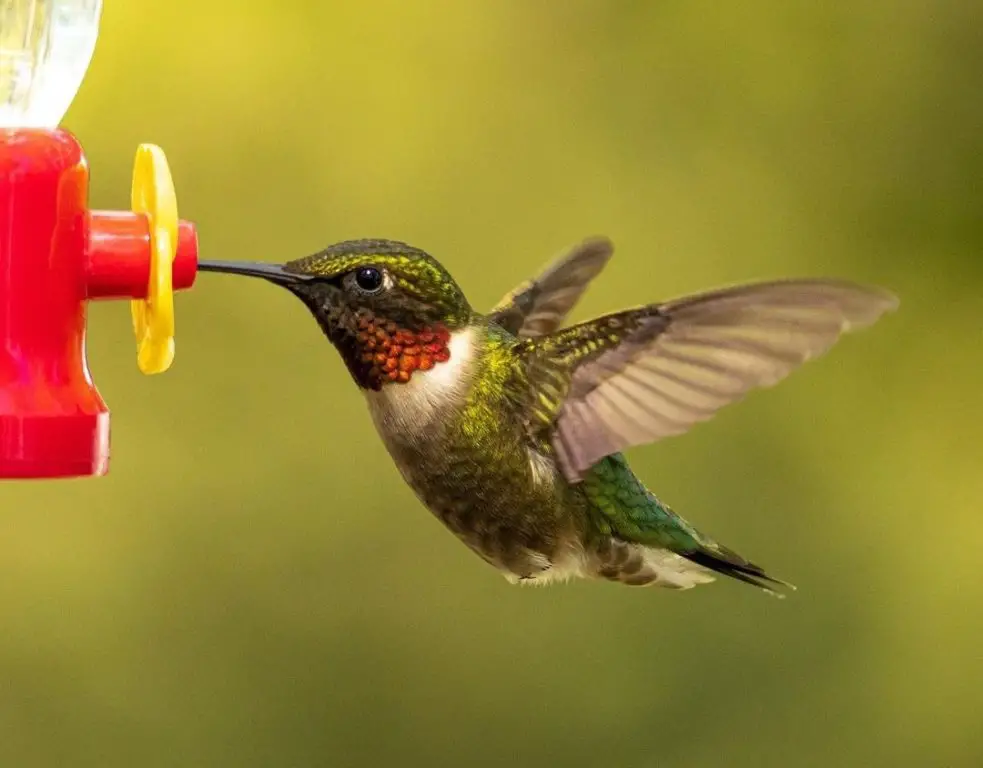
Photo by: MaryLou Ziebarth
Female Ruby-throated hummingbirds have a white throat with some light stippling and are typically larger than the males. The oldest female Ruby-throated hummingbird has been recorded at 9 years, almost double that of the male.
However, the average lifespan of a Ruby-throated hummingbird is approximately 3-5 years.

Photo by: paulapaintsart
Juvenile male and female Ruby-throated hummingbirds during their initial stages of life resemble their mother exhibiting a white throat with light stippling.
As the males mature, they begin to display a few specks of color near their neckline and eventually their bolder red throat feathers become more dominant and stately displaying a colorful gorget.
Juvenile females show a light faint grey stippling on their throat. As both sexes mature their less vivid and lighter colored plumage will begin to mature and become darker in color.
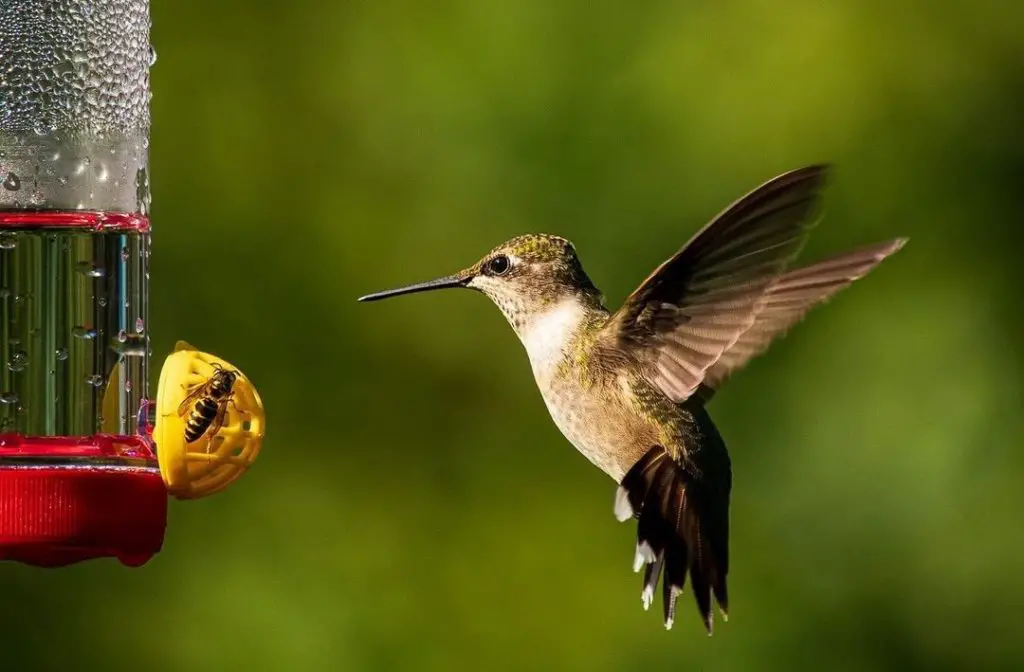
Photo by: MaryLou Ziebarth
Note: It is difficult at a glance to tell the difference between a juvenile male and a female Ruby-throated hummingbird. This picture possibly looks like a juvenile male Ruby-throated hummingbird due to the fact that his throat shows MORE of the light faint stippling than the females with a less distinct white eye accent. In this picture he is also struggling with a bee or wasp situation at the feeder.
See my article: Bees On My Hummingbird Feeder: (9 Tips To Get Rid of Them)
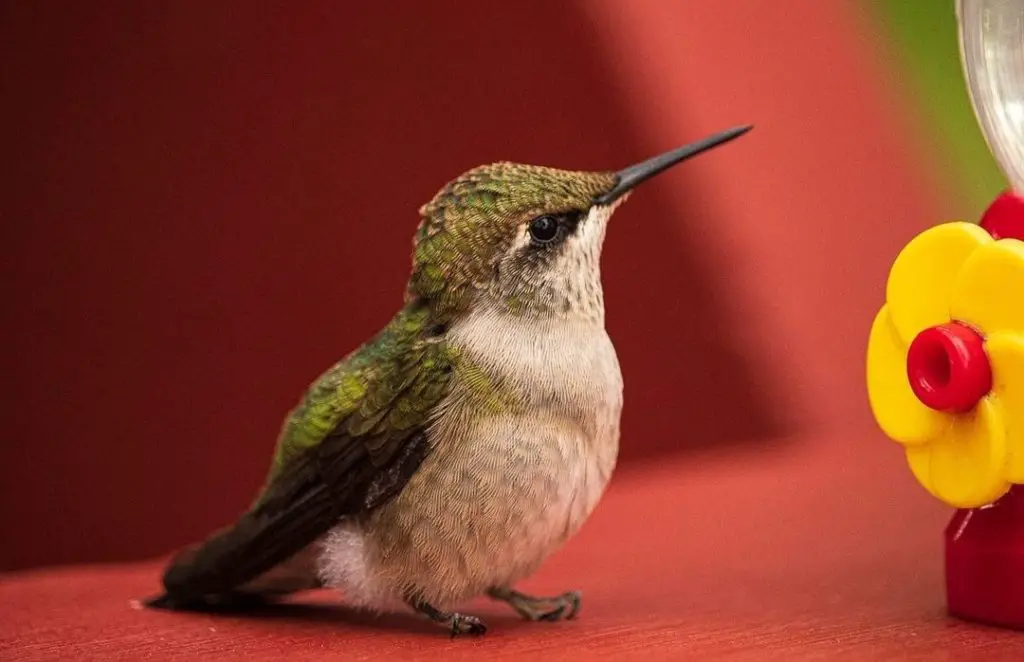
Photo by: MaryLou Ziebarth
Note: The newly white fluffy down feathers on this baby/juvenile Ruby-throated hummingbird’s bottom. Also notice the nice fat reserves they have accumulated by being fed by their diligent mother which will sustain it through adolescence.
According to the United States Department of Agriculture (USDA), Ruby-throated hummingbirds are common summer breeding residents in North Dakota.
Ruby-throated hummingbirds are year-round natives to North Dakota, however some prefer to migrate south to winter in Mexico.
There are two migration routes for the Ruby-throated hummingbird during the spring and fall migrations.
The first migration route is a direct but exhausting nonstop journey southwest over the Gulf of Mexico to Mexico and then down to Central America for the winter. The flight distance over the Gulf of Mexico is over 500 miles. Although this is the direct “short” route, there are numerous obstacles faced by these birds.
Some obstacles include not being able to rest, no means to refuel or eat and having to avoid the dangerous tropical Atlantic hurricanes while flying to their destination. To make matters worse, depending on how you look at it, they migrate during the dark hours of the night or are taking the “Red-eye flight”.
Researchers believe their small size makes the energy expenditure of their grueling trans-oceanic migration pattern more taxing for males than for females even though they both double their body’s fat prior to making the migration across the Gulf of Mexico.
The second migration route is over 2,000 miles, flying along the coastline outlining the Gulf of Mexico. Although this is the “long” route, it allows the opportunity to rest and refuel even though there are fewer food source guarantees along the way.
Scientists are unclear and continue to investigate as to why one group of birds would prefer to take one route over the other.
The Ruby-throated hummingbirds that choose to migrate will first arrive in North Dakota in early April for spring migration and leave by the end of September during fall migration. The last south migrating hummingbirds in the fall to leave North Dakota are gone by October.
See my article: Hummingbird Migration in North Dakota
Ruby-throated hummingbirds prefer open woodland and are often seen in parks, gardens, and backyards as well. They are solitary birds except during mating periods when they are fiercely territorial and aggressive towards hummingbirds of other species.
Even though these hummingbirds have an aggressive side they can still be eaten by predators such as large invertebrates, praying mantises, orb-weaver spiders, and dragonflies.
See pictures of male, female, and juvenile Ruby-throated hummingbirds here…..
Hear sounds of Ruby-throated hummingbirds here…..
RUFOUS HUMMINGBIRD – (Selasphorus rufus)
Conservation Status: Near threatened
Kingdom: Animalia
Phylum: Chordata
Class: Aves
Order: Apodiformes
Family: Trochilidae
Genus: Selasphorus
Species: S. rufous
The Rufous hummingbirds are known as year-round/native hummingbirds in North Dakota, even though some may be year-round while others prefer to migrate.
According to AllAboutBirds.org, there are a couple of species of hummingbirds that tolerate very cold weather and are documented as winter residents in Michigan, upstate New York, Massachusetts, and Wisconsin. The Rufous hummingbird is one species on that list. Their acquired ability to adapt to severe environmental conditions assists them to survive where they may need to over-winter in extremely cold climates such as North Dakota.
The Rufous hummingbird gets its name from the Latin-based word “Red” which is used to describe its reddish-brown coloring.
Male Rufous hummingbirds display an iridescent orange-red gorget, however, in darker lighting it can appear chocolate brown. Their flanks and tail are rusty in color. They have a white to beige underbelly and a black bill. Males can also have green plumage with specks of green color on their rustic-looking backs or on the crown of their head along with chocolate brown dorsal feathers. Their size is 2.8 inches to 3.5 inches in length and weighs 3.2 grams.
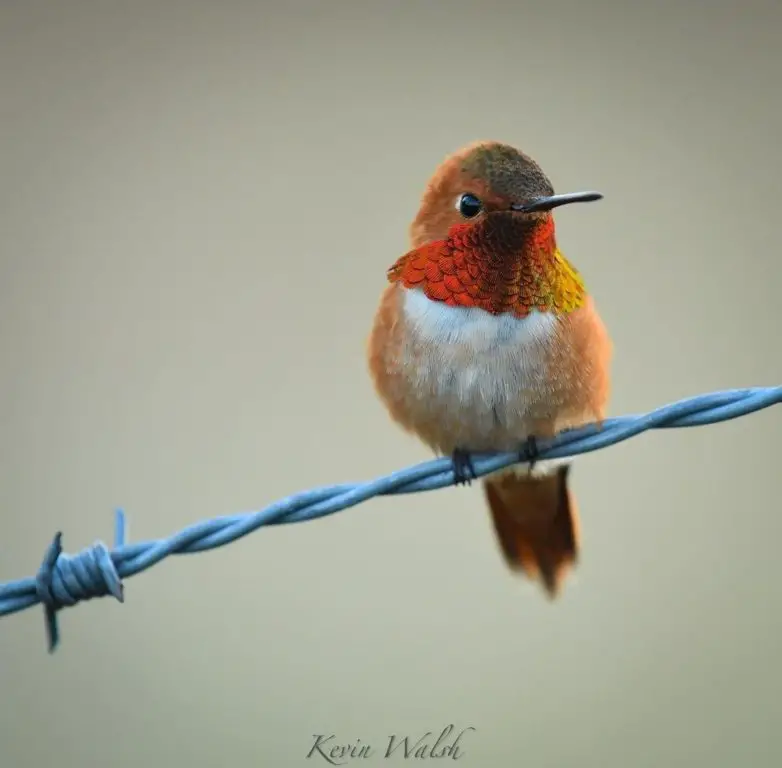
Photo by: Kevin Walsh
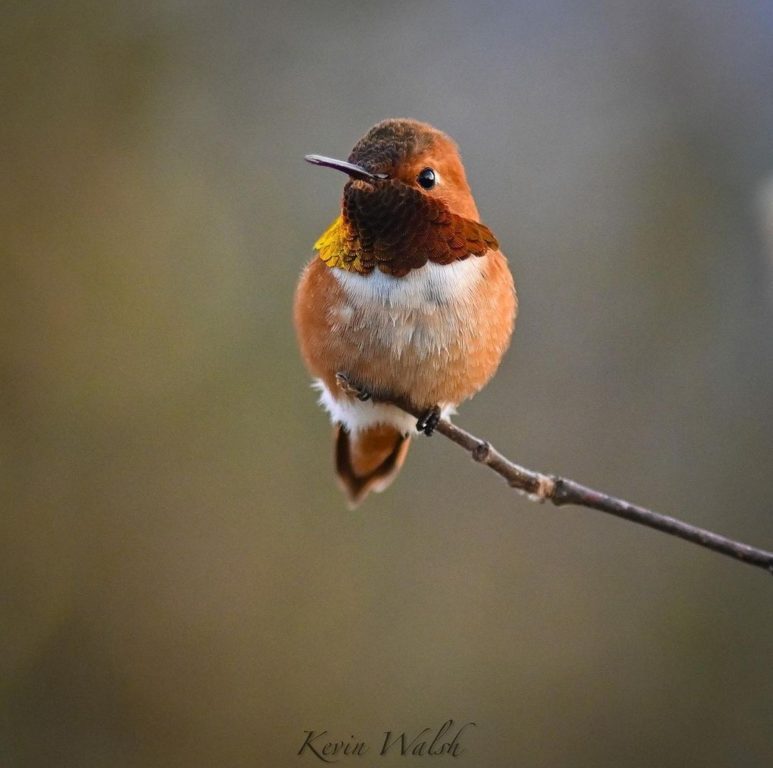
Photo by: Kevin Walsh
Juvenile male Rufous hummingbirds have a rustic look with small iridescent orange specks of color on their throats.
Juvenile Rufous hummingbirds are so similar in coloring and temperament to an Allen’s hummingbird that they are practically indistinguishable in the field. Therefore, identification is established by range rather than appearance.
Female Rufous hummingbirds are green and white with some iridescent orange feathers on their throat. Their tail is dark with white tips and an orange-red base. Female Rufous hummingbirds are slightly larger than the males in anticipation of producing offspring.
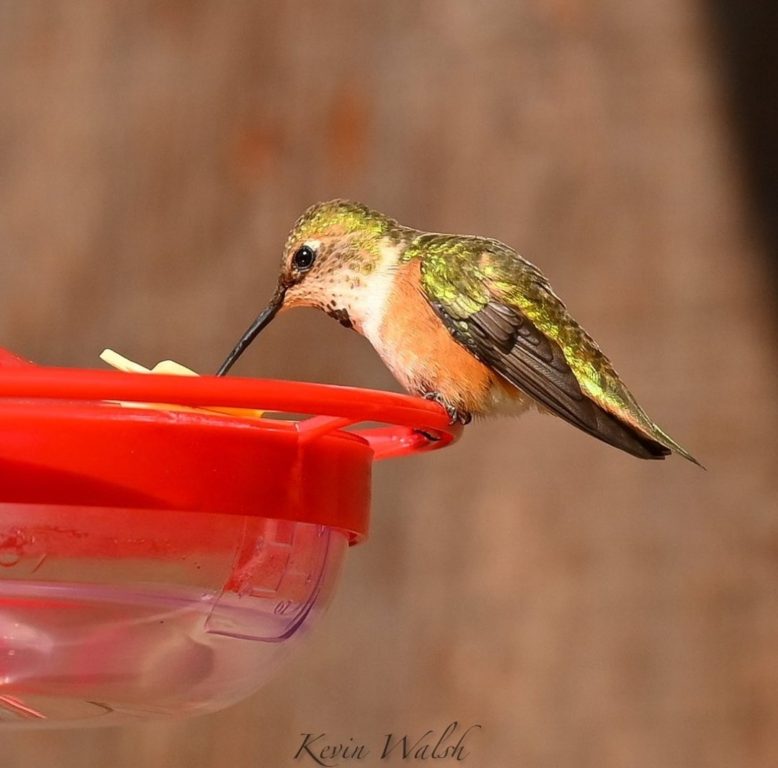
Photo by: Kevin Walsh
Like Allen’s hummingbirds, Rufous hummingbirds are highly territorial and can be aggressive to other hummingbirds and animals. They are fearless and have a reputation to even go as far as to attack squirrels and chipmunks that come too close to their nest. They can outmaneuver all other hummingbirds in the air, making them extremely competitive at feeders.
Rufous hummingbirds make the longest migrations of any other bird in the world, making a clockwise circuit of western America every year that is approximately 3,900 miles.
They have one of the northernmost breeding ranges of any hummingbird in the world, nesting as far north as Alaska. Rufous hummingbirds are polygamous and will mate with several partners in a season.
Rufous hummingbirds have excellent memories and have been known to investigate the location of an old hummingbird feeder years after the feeder has been removed.
During a capture and release banding operation in British Columbia, the oldest living recorded female Rufous hummingbird was 8 years and 11 months old.
See my article: 3 Reasons Why Hummingbirds Are Banded
Due to habitat loss in the Pacific Northwest, Rufous hummingbirds are listed at “near threatened” status by the IUCN red list of threatened species.
See pictures of male, female and juvenile Rufous hummingbirds here…..
Hear sounds of Rufous hummingbirds here…
Seasonal Hummingbirds
The two out of the three seasonal hummingbirds found in North Dakota are the Ruby-throated and the Rufous hummingbirds, the same two as the year-round residents identified above. The third seasonal hummingbird is the Calliope hummingbird mentioned below.
CALLIOPE HUMMINGBIRD – (Selasphorus calliope)
Conservation Status: Least concerned
Kingdom: Animalia
Phylum: Chordata
Class: Aves
Order: Apodiformes
Family: Trochilidae
Genus: Selasphorus
Species: S. calliope
Calliope hummingbirds are occasionally seen in North Dakota, some hummingbird enthusiasts claim. These hummingbirds are in North Dakota temporarily as part of their migratory pattern.
Calliope hummingbirds are the smallest long-distance migratory bird in the world. All tend to breed in the higher elevations of the Rocky Mountains.
They are named after a Greek mythological muse, who represented poetry and eloquence. Calliope means “beautiful voice” in ancient Greek.
Male Calliope hummingbirds are easily identified by their iridescent purple crown and long striking spaced outline row of feathers that project down the sides of their throat. Like many hummingbirds, the backs are metallic green and these birds measure 3 inches in length and weigh 2-3 grams.
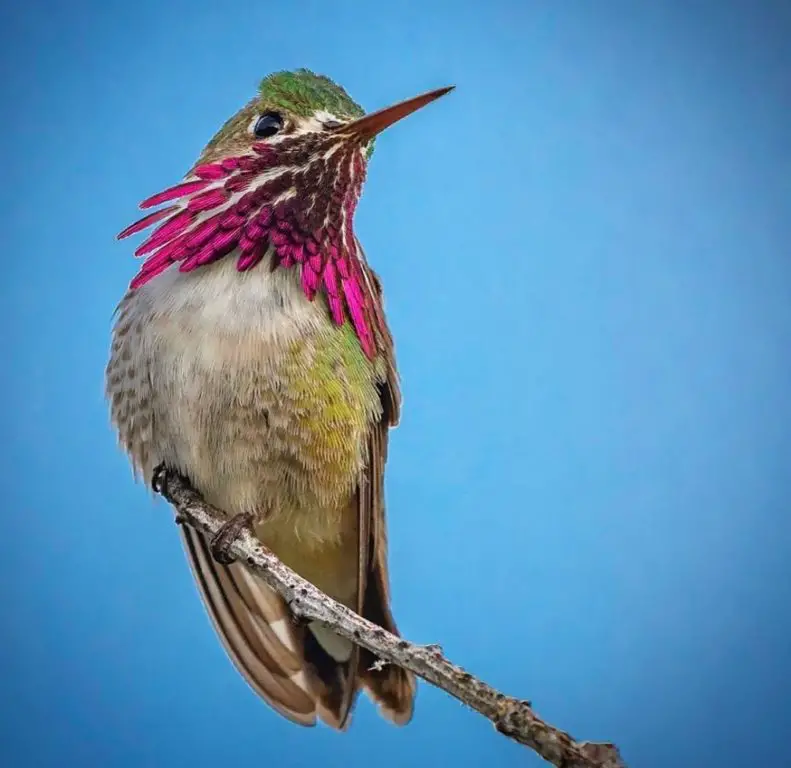
Photo by: sony_alpha_male
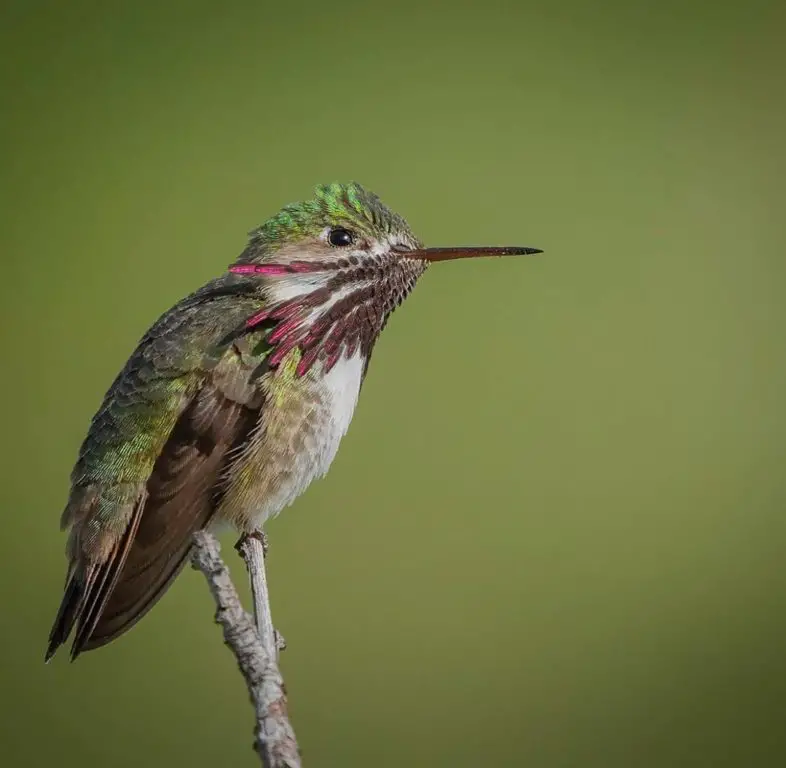
Photo by: sony_alpha_male
Note: His bright throat feathers are slowly coming in.
Female Calliopes have white underbellies and chins with some dark spotting at the throat. They have gray-green crowns and buff-colored flanks which are the underbelly or wing of a bird. Females sport dark tails with white tips.
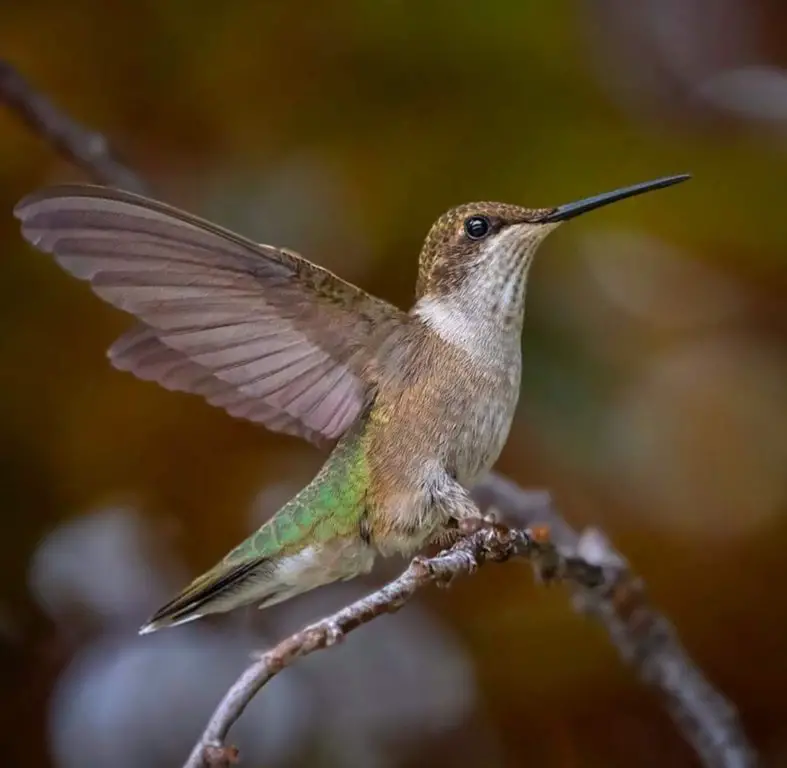
Photo by: sony_alpha_male
Like many hummingbirds, Calliopes communicate not just by their song, but also by manipulating their feathers during flight to make different buzzing noises that act as a form of language and communication.
Male Calliope hummingbirds establish a breeding territory and mate with every available female hummingbird that accepts his courtship.
When a female Calliope hummingbird builds a nest, they are known to both nest on the top of pine cones and to steal building materials from the nests of other birds in order to construct their own. They will also dismantle nests from previous seasons and recycle them in their new nest.
Therefore, they are often attacked and chased by larger, more aggressive species of hummingbirds, such as Allen’s and Rufous hummingbirds. This causes them to maintain a relatively low profile in comparison to other species.
Because Calliope hummingbirds have a more restricted wintering range than most hummingbirds, they are particularly vulnerable to habitat loss and natural disasters, such as climate change and wildfires.
During a capture and release banding operation in Idaho, the oldest living recorded female Calliope hummingbird was 8 years and 11 months old when she was captured twice, once in 2007 and again in 2014.
See my article: 3 Reasons Why Hummingbirds Are Banded
See pictures of male, female and juvenile Calliope hummingbirds here…..
Hear sounds of Calliope hummingbirds here…..
Rare/Vagrant Hummingbirds
The one out of the three rare/vagrant hummingbirds found in North Dakota is the same as the seasonal resident, the Calliope hummingbird identified above. The other two are the Anna’s and the Broad-tailed hummingbird mentioned below.
ANNA’S HUMMINGBIRD – (Calypte anna)
Conservation Status: Least concerned
Kingdom: Animalia
Phylum: Chordata
Class: Aves
Order: Apodiformes
Family: Trochilidae
Genus: Calypte
Species: C. anna
Anna’s hummingbirds are named after Anna Massena, Duchess of Rivoli. These birds are rare/accidental vagrants to North Dakota since they are a common resident on the western coast.
Male Anna’s hummingbirds are the only hummingbird species in North America with a red crown. They are identified as mostly green, gray, and magenta in color. The males have a flashy and colorful iridescent magenta gorget and crown. Their size ranges from 3.5 inches to 4.3 inches in length and they weigh 2.4 to 4.5 grams.
The gorget on a male hummingbird is named after the protective metal piece in a suit of armor that covers the wearer’s throat to prevent injury when in battle. Since male hummingbirds are very aggressive with each other when fighting for their own territory, this name is appropriate and fitting to describe their physical attributes.
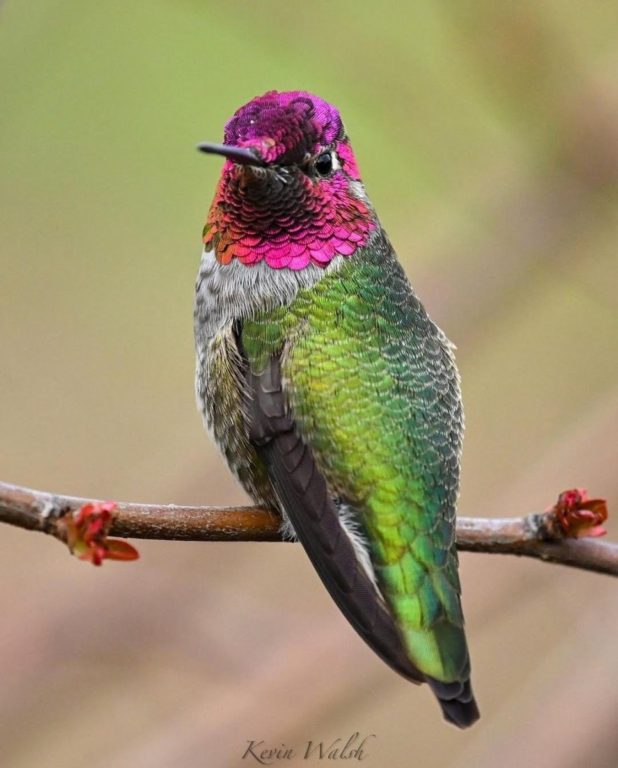
Photo by: Kevin Walsh
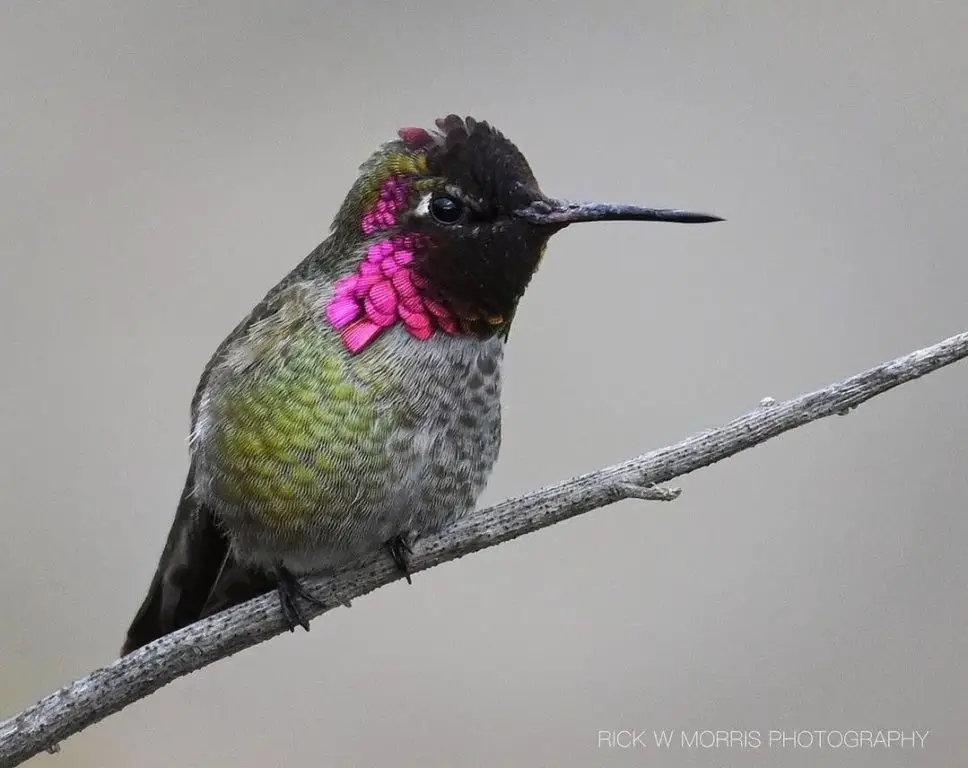
Photo by: rwm_inthewild
Female Anna’s hummingbirds are overall not as colorful as the males, appearing pale green in color. Females can also have a gorget, but it is a smaller patch of magenta. Females tend to have a pale white line over each eye that makes them distinctive.
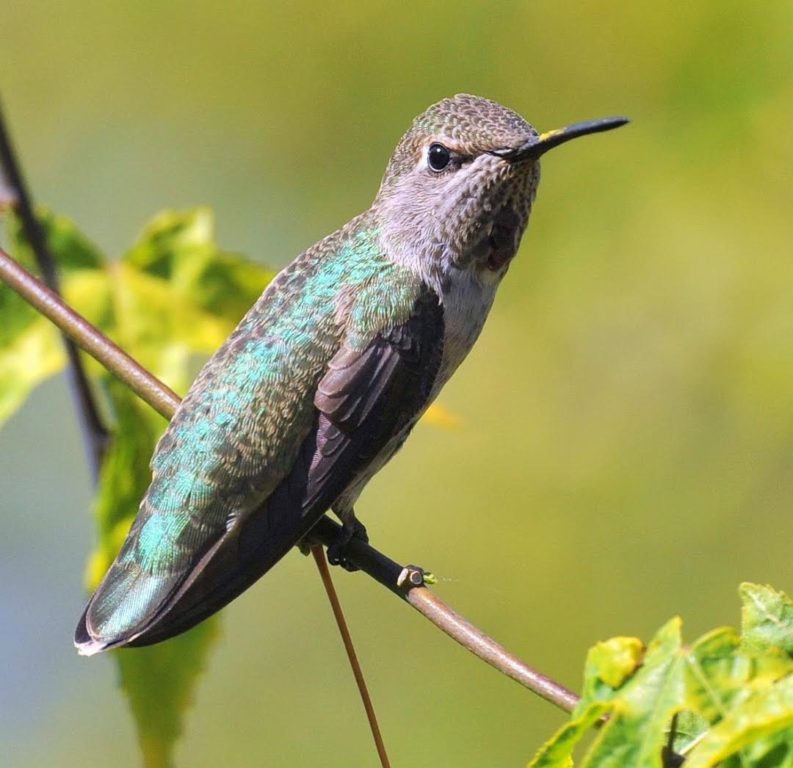
Photo by: rwm_inthewild
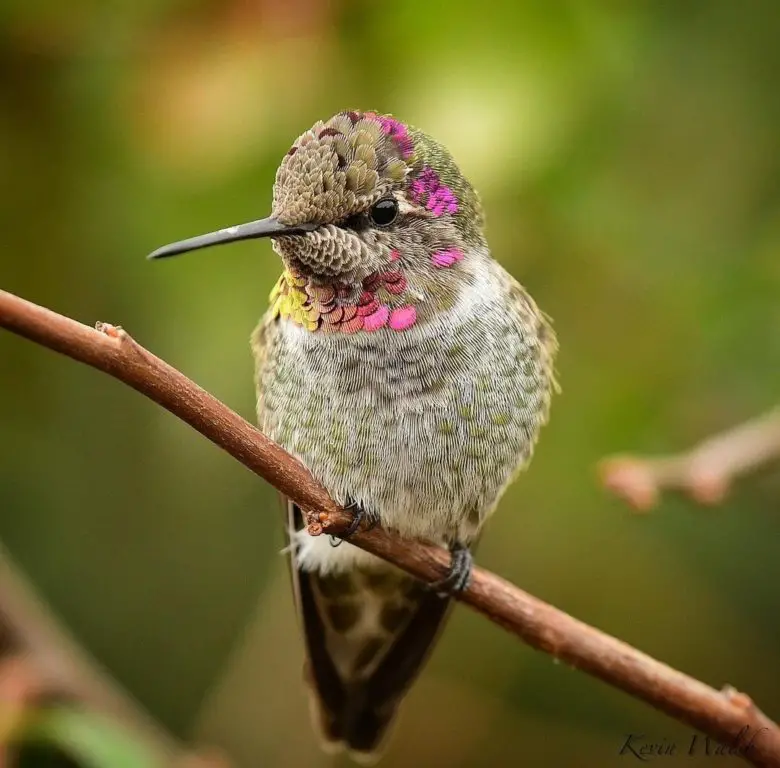
Photo by: Kevin Walsh
Note: This Anna’s hummingbird could be a juvenile in those awkward teenage years or it could be during a molting stage.
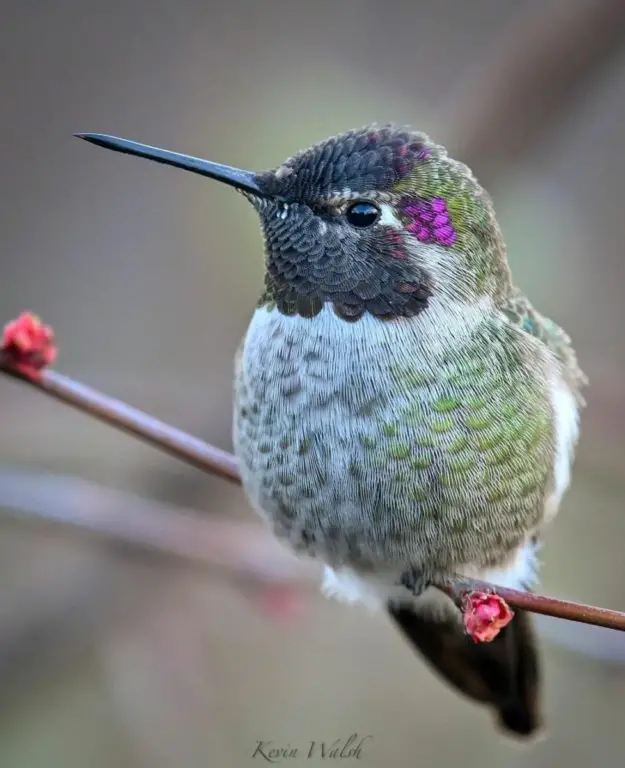
Photo by: Kevin Walsh
Note: This juvenile male Anna’s Hummingbird is beginning to show his magenta head feathers near his temple along with some faint color starting to show on his gorget.
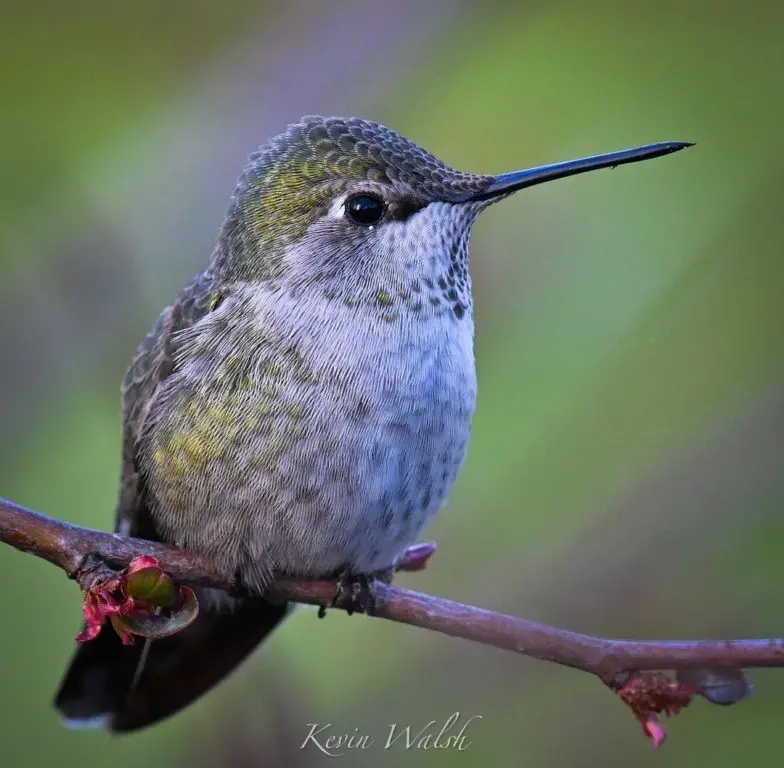
Photo by: Kevin Walsh
The Anna’s hummingbird predominantly breeds in northern Baja California and parts of Southern California, however, due to the transplanting of exotic ornamental plants in residential areas along the Pacific Coast and Inland Deserts, their breeding range has expanded up the Western Seaboard. Anna’s hummingbirds have the northernmost year-round range of any hummingbird species.
Female Anna’s hummingbirds raise their young with no help from the males.
Anna’s hummingbirds protect their territory with elaborate dives targeted towards predatory birds and even towards people they perceive to be threatening.
See pictures of male, female and juvenile Anna’s hummingbirds here…..
Hear sounds of Anna’s hummingbirds here…..
BROAD-TAILED HUMMINGBIRD – (Selsaphoris platycercus)
Conservation Status: Least concerned
Kingdom: Animalia
Phylum: Chordata
Class: Aves
Order: Apodiformes
Family: Trochilidae
Genus: Selsaphoris
Species: S. platycercus
The Broad-tailed hummingbird, though usually residing in Mexico and as far south as Guatemala during the winter, are extremely rare and generally not found in North Dakota.
They have a migrant and non-migrant population that begins in the south of Mexico. The ones that migrate north to breed will do so during spring migration and will pass through Arizona, Colorado, Wyoming, Idaho and reach as far north as Montana.
Once the breeding season is complete, Broad-tailed hummingbirds once again depart and begin their southbound fall migration to Mexico in September to winter and meet up with their non-migrant population.
Male Broad-tailed hummingbirds have an iridescent ruby-red gorget. Both males and females Broad-tailed hummingbirds have green topside and pale underbellies with bright white eye rings and broadly rounded tails. Their size is medium build and ranges from 3.3 inches to 3.8 inches in length and weighs 3.6 grams.
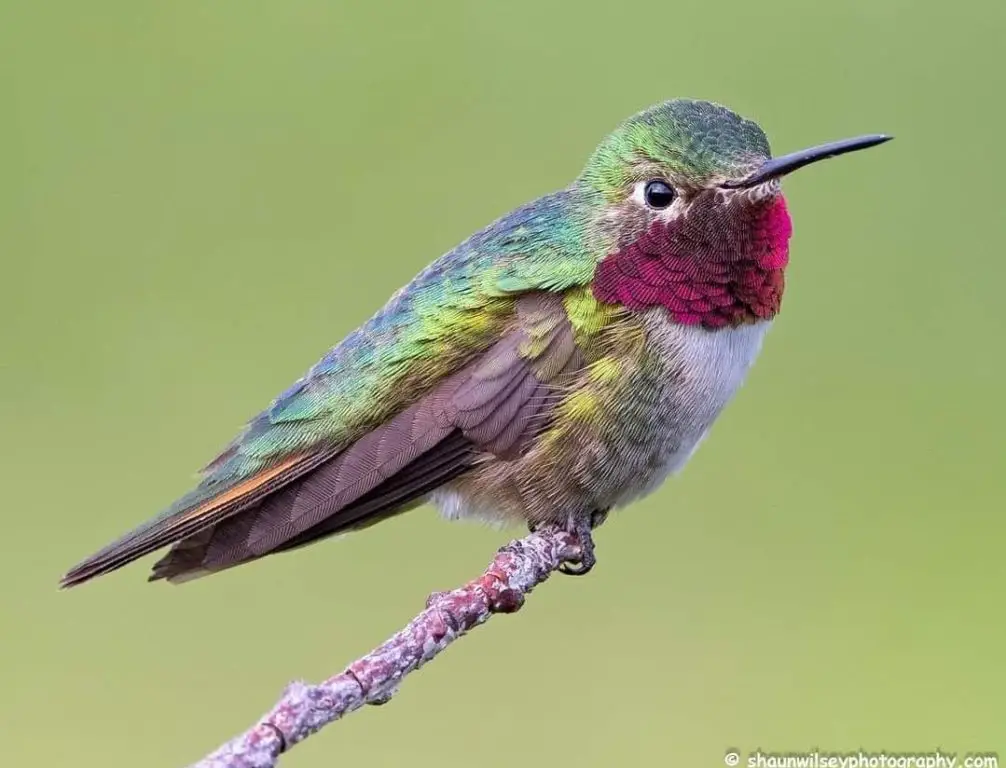
Photo by: shaunwilseyphotography
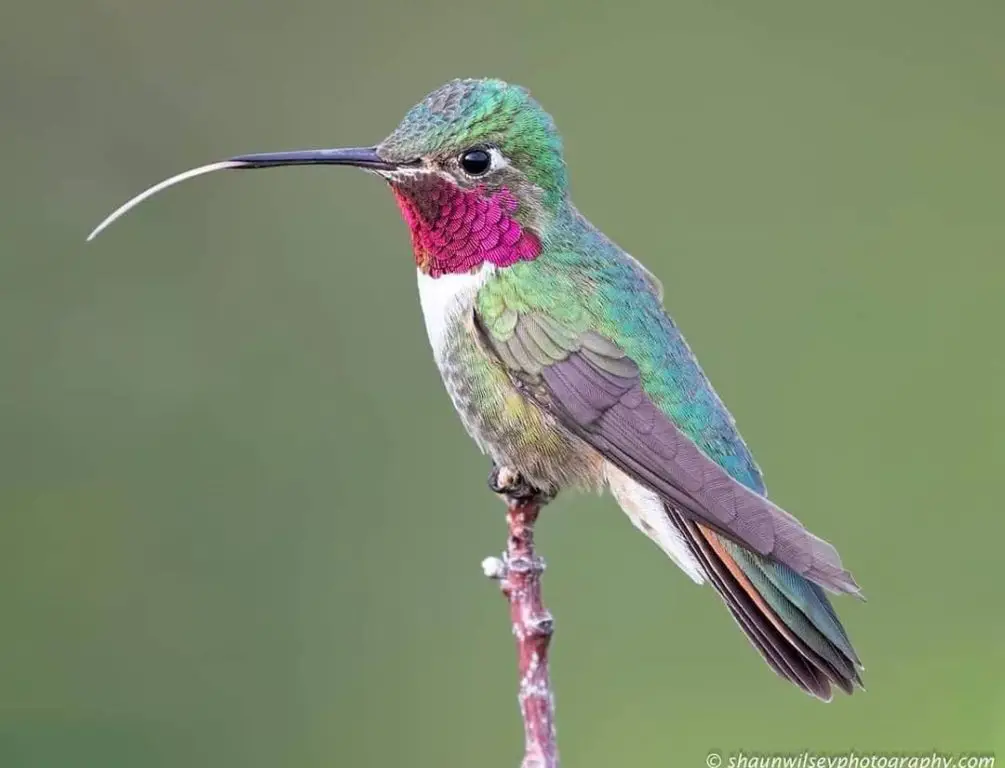
Photo by: shaunwilseyphotography
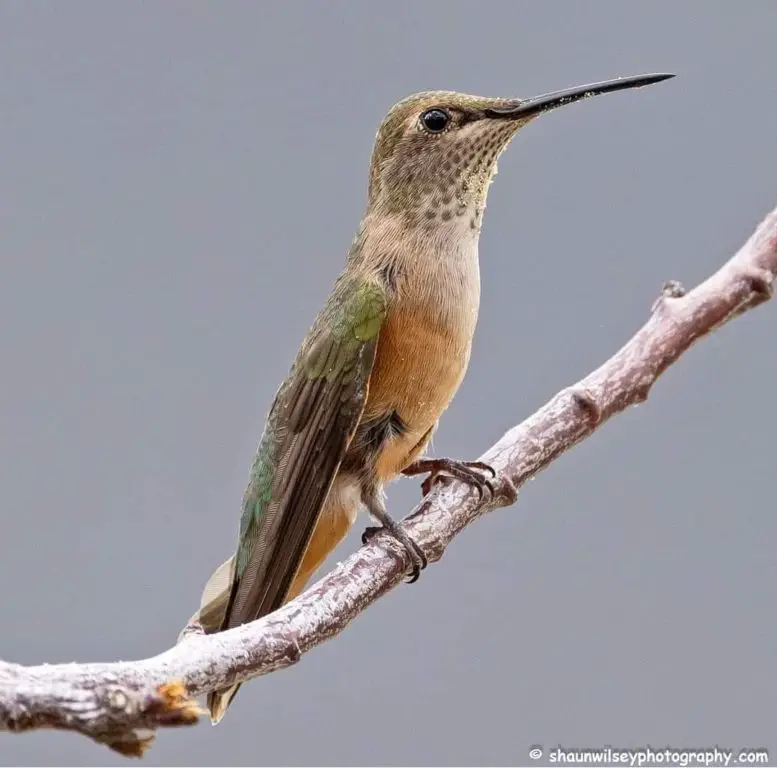
Photo by: shaunwilseyphotography
Note: The thick blanket of pollen on its bill and throat. This juvenile Broad-tailed hummingbird has been busy pollinating and drinking nectar from flowers to sustain its high metabolism.
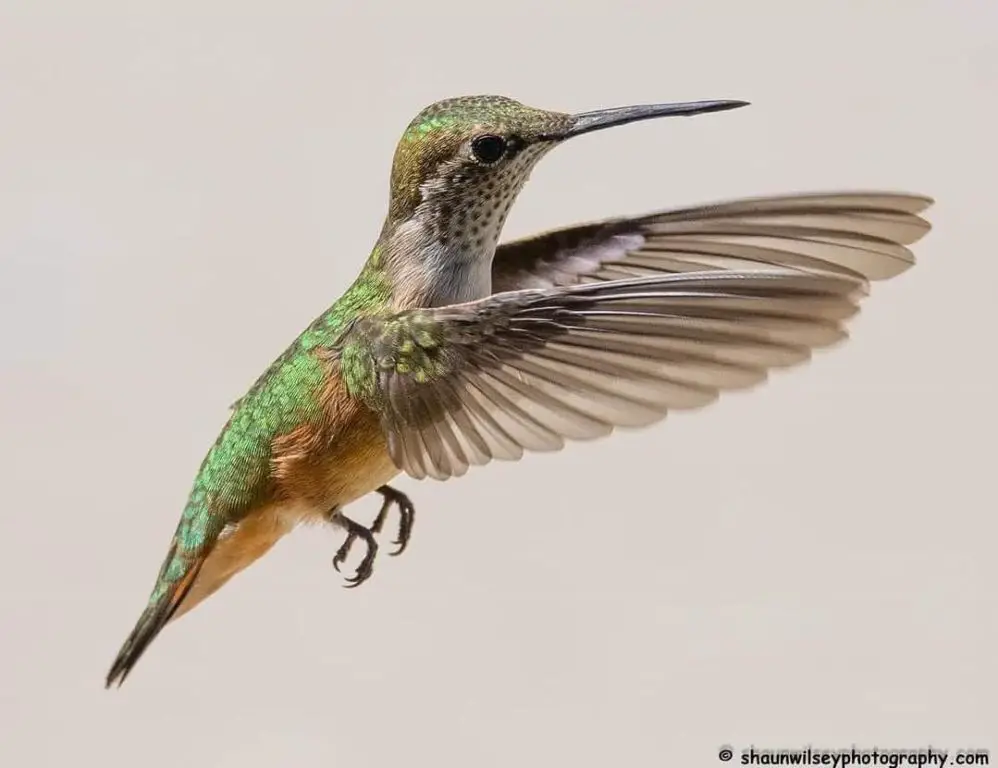
Photo by: shaunwilseyphotography
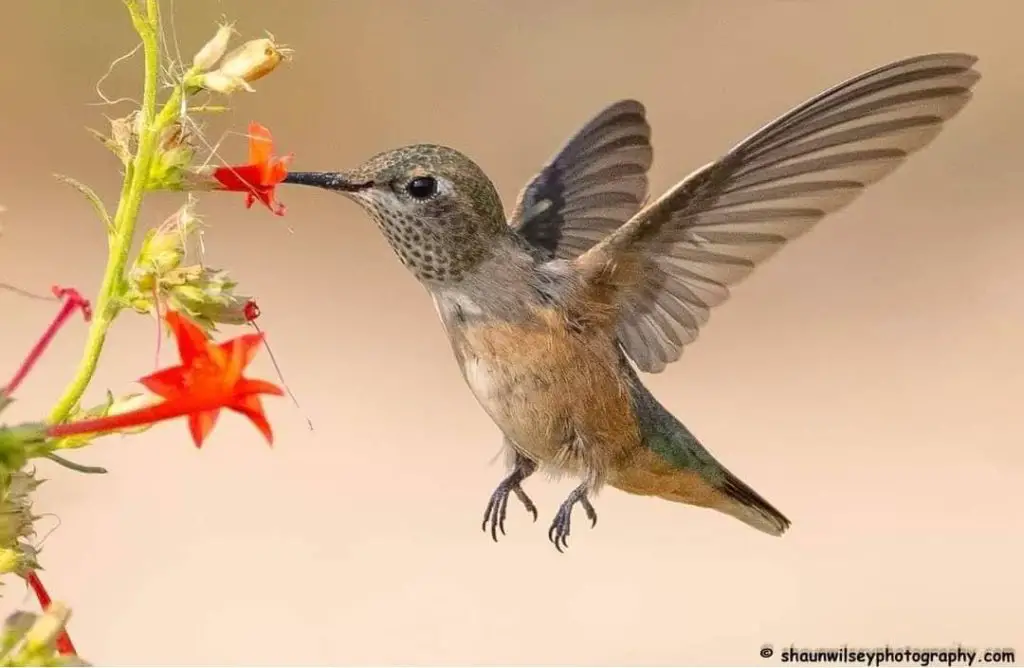
Photo by: shaunwilseyphotography
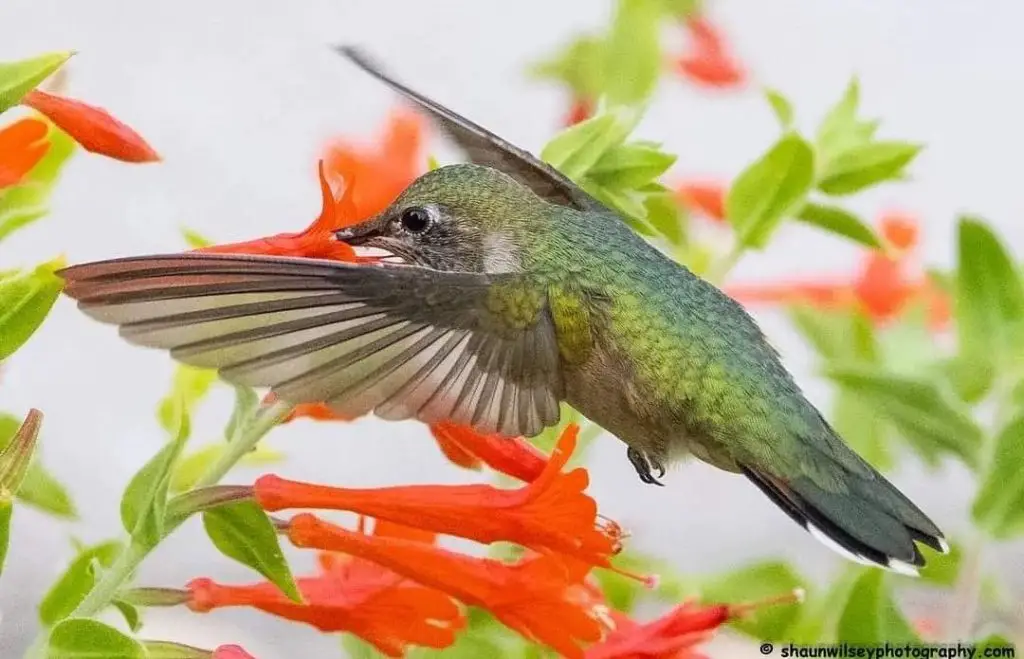
Photo by: shaunwilseyphotography
Flower: Scarlet Mint
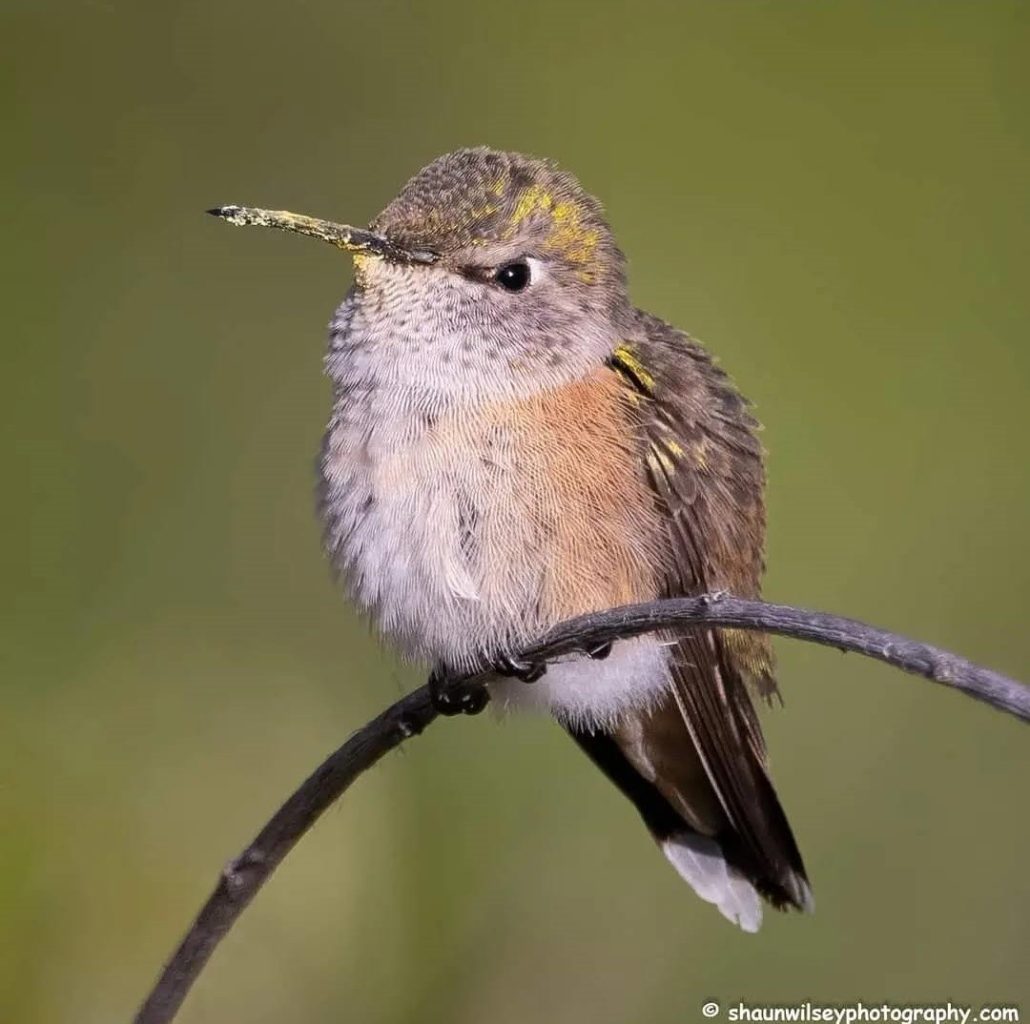
Photo by: shaunwilseyphotography
Note: The newly white fluffy down feathers on this baby/juvenile Broad-tailed hummingbird’s bottom. Also notice the nice fat reserves they have accumulated by being fed by their diligent mother which will sustain it through adolescence.
This species of hummingbird favors habitats in the understory of mature forest woodlands such as pine and oak groves. They chose to nest on the branches of trees and have been known to return to the same nesting ground each year, roughly 70% of the time.
Their breeding time coincides with the peak time of flowering native plants for maximum food resource availability. Their favorite nectar producing flower plants include: Red Columbine, Indian Paintbrush, Sage varieties, Currants and Scarlet Mint.
Broad-tailed hummingbirds commonly nest in Montana during the summer, however they are rare visitors to their neighboring state, North Dakota. Their nests are often located over riparian corridors.
They are promiscuous and do not form any kind of a pair bond between male and female birds and again the female raises the young alone.
The Broad-tailed hummingbird has suffered a decline in population since the 1990s, but presently, its population is stable, and it has been shown to have adapted to human habitat encroachment.
See pictures of male, female, and juvenile Broad-tailed hummingbirds here…..
Hear sounds of Broad-tailed hummingbirds here…..
Keep your eyes peeled, observe and enjoy the multiple types of hummingbirds found in North Dakota!
See my article: Hummingbird Migration in North Dakota
Happy Hummingbird Watching!
Backyard Visitors participates in affiliate programs which compensate us for referring traffic.

